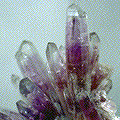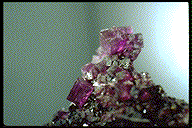Mineral Search
Search Hints & Glossary of Terms
How the Mineral Full Text Search works:
- The search program takes the list of words and retrieves the HTML documents that
contain any of the words in the list. There are no logical operators such as AND or OR or NOT. Documents are assigned a value based upon
- How many times the words appear in the document.
- How frequently the words occur (words that only appear in a few documents are more valuable).
- Capitalized phrases (such as Calcium Carbonate) are also compared as matching word pairs and are assigned a high value.
Search Hints
- Use our descriptive words (see below) such as vitreous or perfect (meaning
vitreous luster or perfect cleavage)
- Use capitalized word pairs when possible and applicable (such as Elmwood, Tennessee).
- Words that appear in all mineral descriptions (such as luster or cleavage) are useless, except when used as capitalized word pairs (Botryoidal Habit).
- At present, phrases with numeric values do not work well (such as "hardness 6"), and ranges do not work at all. We hope to improve this behavior in the future.
- Use capitalized word pairs when possible and applicable (such as Elmwood, Tennessee).
Glossary of Terms
- This section describes the various mineral terms as we use them in the Physical Characteristics
section of each mineral description. Using our definitions will improve searching success!
- Luster
- silky
- greasy
- vitreous
- pearly
- metallic
- dull
- greasy
- Transparency
- opaque
- translucent
- transparent
- translucent
- Crystal System
- monoclinic
- cubic
- tetragonal
- orthorhombic
- triclinic
- trigonal
- hexagonal
- cubic
- Crystal Habits
- any of the following may be curved or distorted
- prismatic
- dendritic
- acicular
- tabular
- botryoidal
- mammilary
- granular
- massive
- prismatic
- Cleavage
- perfect
- distinct
- indistinct
- absent
- distinct
- Fracture
- uneven
- conchoidal
- hackly
- splintery
- conchoidal
- Hardness
- 1 - Talc
- 2 - Gypsum
- 3 - Calcite
- 4 - Fluorite
- 5 - Apatite
- 6 - Orthoclase
- 7 - Quartz
- 8 - Topaz
- 9 - Corundum
- 10 - Diamond
- 2 - Gypsum
- Specific Gravity
- light
- average
- heavy
- very heavy
- average
OTHER:
- It may help to name associated minerals such as quartz or pyrite
- It may help to identify the host rock, such as pegmatite or schist
- It may help to identify where it was found or mined, such as North Carolina
- It may help to list any likely elements in the chemical name, such as lithium or sulfide (possibly guessed from density or associations)
- Do not name negatives ("no cleavage") - it doesn't work
- Do name any known unusual characteristics, such as "radioactive" or "fluorescent"
EXAMPLES:
- yellow orthorhombic transparent prismatic
- silky translucent botryoidal green
- metallic blue sulfide
- radioactive opaque green
- heavy red hexagonal North Carolina










